Articles
- Page Path
- HOME > J Korean Acad Nurs > Volume 41(1); 2011 > Article
-
Original Article
- Development and Evaluation of 「Hospice Smart Patient」 Service Program
- Chai-Soon Park, Yang-Sook Yoo, Dong-Won Choi, Hyun-Jeong Park, Ji-In Kim
-
Journal of Korean Academy of Nursing 2011;41(1):9-17.
DOI: https://doi.org/10.4040/jkan.2011.41.1.9
Published online: February 28, 2011
1Professor, College of Nursing, The Catholic University of Korea, Seoul, Korea.
2Assistant Professor, Red Cross College of Nursing, Seoul, Korea.
3Full-time Instructor, College of Nursing, The Catholic University of Korea, Seoul, Korea.
4Research Assistant, Institute for Hospice/Palliative Care, The Catholic University of Korea, Seoul, Korea.
- Address reprint requests to: Choi, Dong-Won. Red Cross College of Nursing, 98 Saemunan-gil, Jongno-gu, Seoul 110-102, Korea. Tel: +82-2-3700-3684, Fax: +82-2-3700-3400, dionia21@redcross.ac.kr
© 2011 Korean Society of Nursing Science
Abstract
-
Purpose
- The purpose of this study was to develop and implement the Hospice Smart Patient Program and to evaluate its effectiveness.
-
Methods
- It was quasi-experimental non-equivalent pre-post study. Breast cancer patients who underwent surgery, chemotherapy or radiotherapy, or who needed palliative care, participated in the study. Participants were divided into two groups, experimental and control groups based on their preferences. The program was developed after literature review and discussion among experts on hospice and palliative care. Participants who were in the experimental group received either face-to-face or phone 「Hospice Smart Patient」 Service at least once a week for 5 months.
-
Results
- There was a significant difference in quality of life and communication skill between the two groups after the service was provided. In addition, participants in experimental group showed improved decision making skills, mastery sense, and understanding of hospice and palliative care, which would be beneficial in improving their quality of life.
-
Conclusion
- We have concluded that the 「Hospice Smart Patient」 Program is useful for cancer patients in decision making, improving self-control and choosing hospice care to improve their quality of life.
This study was supported by a grant from the National R&D Program for Cancer Control, Ministry for Health, Welfare and Family affairs, Republic of Korea (0720360).
- 1. Family doctor: Health information for the whole family. American Academy of Family Physicians. 2009;Retrieved March 5, 2010. from http://familydoctor.org/online/famdocen/home.html.
- 2. Bienvenu MJ. An interpersonal communication inventory. Journal of Communication. 1971;21:381–388.Article
- 3. Boström B, Hinic H, Lundberg D, Fridlund B. Pain and health-related quality of life among cancer patients in final stage of life: A comparison between two palliative care teams. Journal of Nursing Management. 2003;11:189–196.ArticlePubMed
- 4. Cegala DJ, McClure L, Marinelli TM, Post DM. The effects of communication skills training on patients' participation during medical interviews. Patient Education and Counseling. 2000;41:209–222.ArticlePubMed
- 5. Cohen J. Statistical power analysis for the behavioral sciences. 1988;2nd ed. Hillsdale, NJ, Lawrence Erlbaum Associates.
- 6. Disease, treatment, pregnancy, fitness, weight loss: Discovery health. Discovery Communications. 2009;Retrieved March 5, 2010. from http://health.discovery.com.
- 7. Ferrell BR, Coyle N. Textbook of palliative nursing. 2006;2nd ed. Oxford, Oxford University Press.
- 8. Gill KM, Mishel M, Belyea M, Germino B, Germino LS, Porter L, et al. Triggers of uncertainty about recurrence and long-term treatment side effects in older African American and Caucasian breast cancer survivors. Oncology Nursing Forum. 2004;31:633–639.ArticlePubMed
- 9. Healy B. Find a mentor. U.S. News & World Report. 2004;137:54–55.
- 10. Hwang MS, Ryu HS. Effects of a palliative care program basedon home care nursing. Journal of Korean Academy of Nursing. 2009;39:528–538.ArticlePubMed
- 11. Chang SY. Effects of aroma hand massage on pain, state anxiety and depression in hospice patients with terminal cancer. Journal of Korean Academy of Nursing. 2008;38:493–502.ArticlePubMed
- 12. Jo KH, Son BK. The relationship of uncertainty, hope and quality of life in patients with breast cancer. Journal of Korean Academy of Nursing. 2004;34:1184–1193.ArticlePubMedPDF
- 13. Kang KJ. Effects of the communication training program. 1996;Changwon, Changwon National University. Unpublished master's thesis.
- 14. Kim DH. Medical communication: Three function approach. Health Communication. 2006;1:1–6.
- 15. Kim KU. Development and validation of the Korean version of the Mcmaster Quality of Life Scale (K-MQLS): On the hospice and palliative care patients. 2005;Seoul, Korea University. Unpublished doctoral dissertation.
- 16. Kim SH. Factors affecting communication between cancer patients and nurses. 2009;Kyungsan, Youngnam University. Unpublished master's thesis.
- 17. Kim TS, Yang BG, Jeong EK, Park NR, Lee YS, Lee YS, et al. Need assessment of home based cancer patients. Korean Journal of Hospice and Palliative Care. 1999;2:36–45.
- 18. Kim YM, Bazant E, Storey JD. Smart patient, smart community: lmproving client participation in family planning consultations through a community education and mass-media program in Indonesia. International Quarterly of Community Health Education. 2006;26:247–270.PubMed
- 19. Korea National Statistical Office. 2007 Annual report of causes of deaths. 2007;Daejeon, Author.
- 20. National Cancer Center. Korean hospice palliative care standards and regulations. 2003;Goyang, Author.
- 21. National Cancer Center. Public attitudes toward dying with dignity. 2008;Goyang, Author.
- 22. Park CS, Yoo YS, Park HJ, Choi DW, Choe SO, Kim SE, et al. Development of educational program for hospice smart patient service provider. Journal of Korean Oncology Nursing. 2009;9:43–51.
- 23. Roizen MF, Oz MC. You: The smart patient. 2006;New York, Simon & Schuster New York.
- 24. Smart Patient, L.L.C: Customized medical research and information reports. Smart Patient. 2007;Retrieved March 5, 2010. from http://www.smartpatientonline.com.
- 25. The Research Institute for Hospice/Palliative Care. The Catholic University of Korea. The development of standards of hospice nursing in Korea. 2003;Seoul, Author.
- 26. Yun YH, Rhee YS, Nam SY, Chae YM, Heo DS, Lee SW, et al. Public attitudes toward dying with dignity and hospice/palliative care. Korean Journal of Hospice and Palliative Care. 2004;7:17–28.
REFERENCES
Figure & Data
REFERENCES
Citations

- Palliative care in the treatment of women with breast cancer: A scoping review
Romel Jonathan Velasco Yanez, Ana Fátima Carvalho Fernandes, Erilaine de Freitas Corpes, Régia Christina Moura Barbosa Castro, Judith Sixsmith, Luís Carlos Lopes-Júnior
Palliative and Supportive Care.2024; 22(3): 592. CrossRef - Efficacy of a Digital Health Tool on Contraceptive Ideation and Use in Nigeria: Results of a Cluster-Randomized Control Trial
Stella Babalola, Caitlin Loehr, Olamide Oyenubi, Akinsewa Akiode, Allison Mobley
Global Health: Science and Practice.2019; 7(2): 273. CrossRef - Psychometric Properties of the Korean Version of the HIV Self-Management Scale in Patients with HIV
Gwang Suk Kim, Sang Hui Chu, Yunhee Park, Jun Yong Choi, Jeong In Lee, Chang Gi Park, Linda L. McCreary
Journal of Korean Academy of Nursing.2015; 45(3): 439. CrossRef - Effectiveness and cost-effectiveness of home palliative care services for adults with advanced illness and their caregivers
Barbara Gomes, Natalia Calanzani, Vito Curiale, Paul McCrone, Irene J Higginson, Maja de Brito
Cochrane Database of Systematic Reviews.2013;[Epub] CrossRef
The Contents for Smart Patients Service Program
Contents of Guidebook, Handbook and Communication Guidelines
Individual Characteristics and Homogeneity Test
*Fisher's exact test.
Differences between Experimental and Control Groups
Exp.=Experimental group (n=20); Cont.=Control group (n=20); QOL=Quality of life.
Service Evaluation
*Fisher's exact test.
Exp.=Experimental group (n=20); Cont.=Control group (n=20); QOL=Quality of life.
 KSNS
KSNS
 E-SUBMISSION
E-SUBMISSION
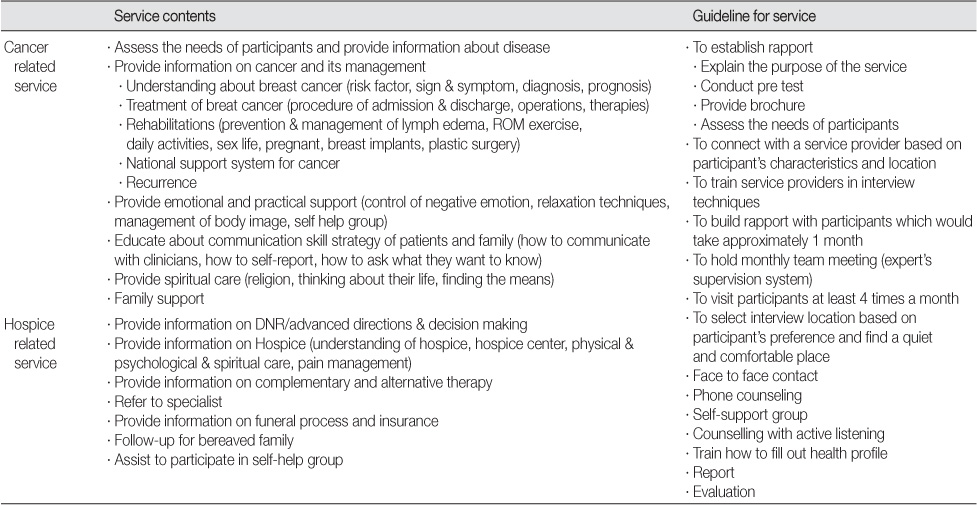
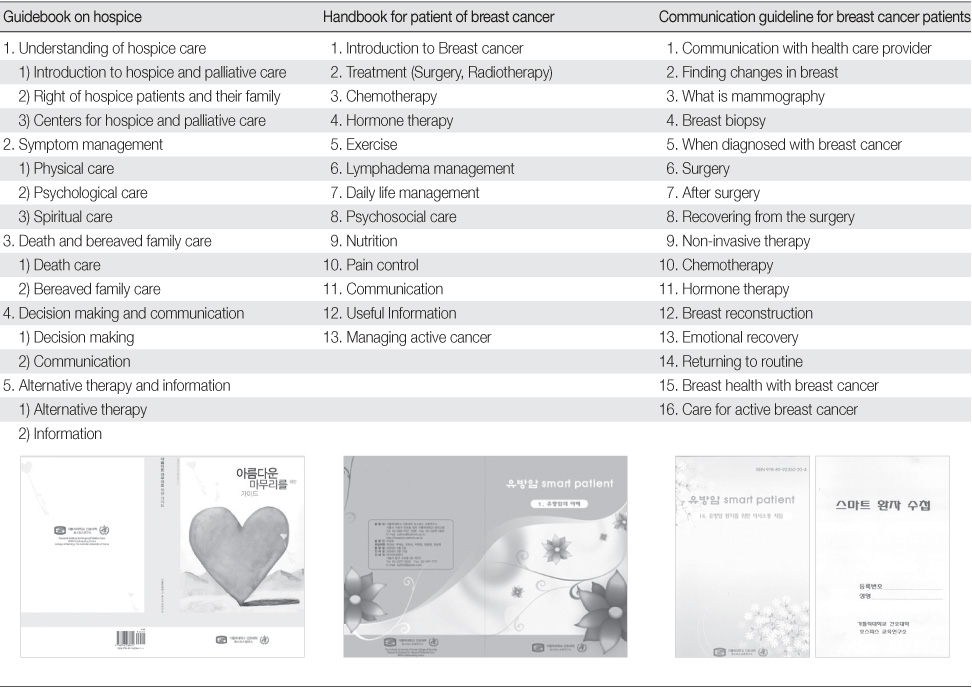
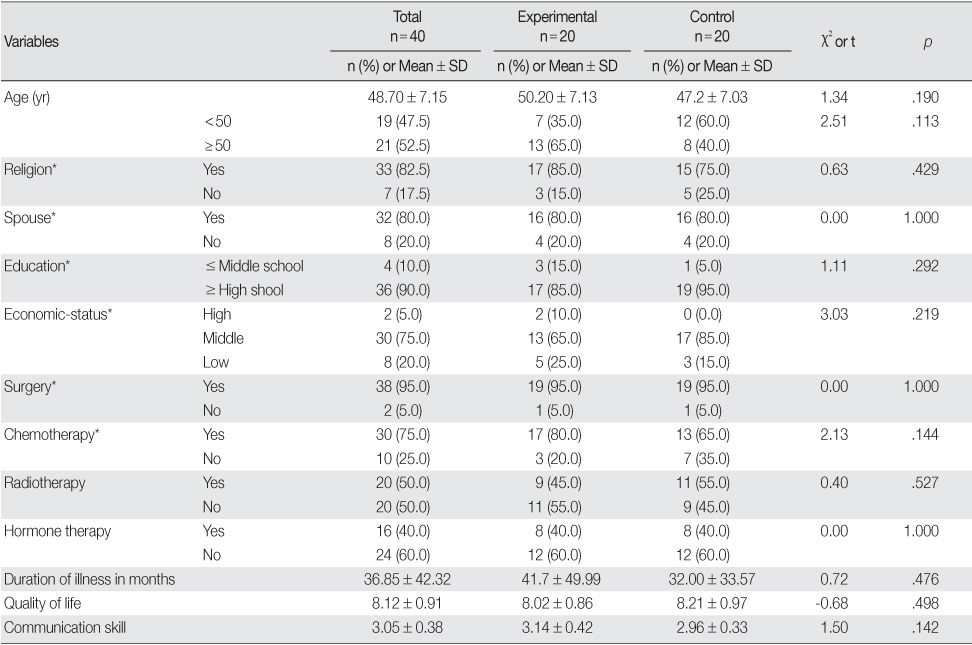
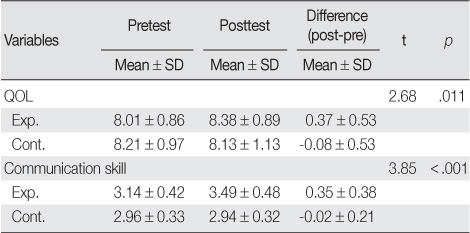
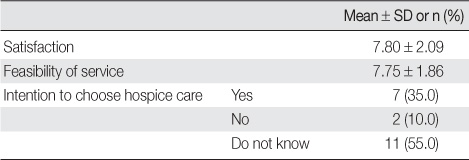
 Cite
Cite

